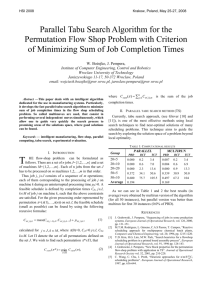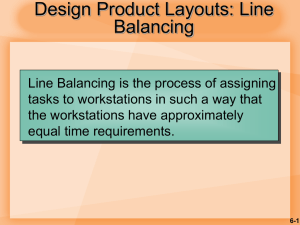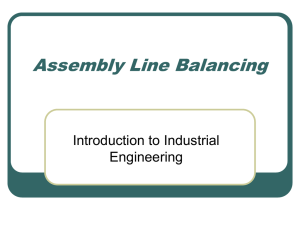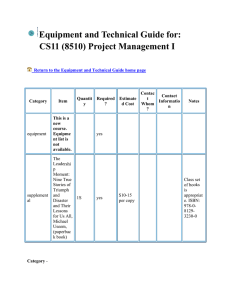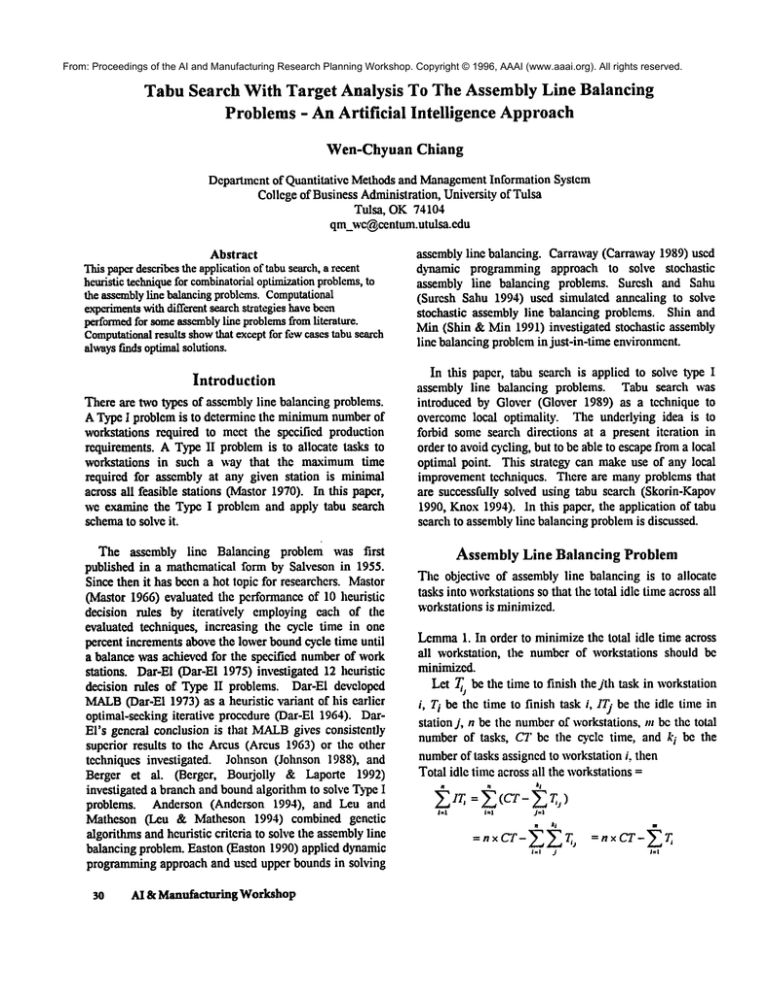
From: Proceedings of the AI and Manufacturing Research Planning Workshop. Copyright © 1996, AAAI (www.aaai.org). All rights reserved.
Tabu Search With Target Analysis To The Assembly Line Balancing
Problems - An Artificial Intelligence Approach
Wen-ChyuanChiang
Departmentof Quantitative Methodsand Management
Information System
Collegeof BusinessAdministration,Universityof Tulsa
Tulsa, OK74104
qm_wc@centum.utulsa.edn
Abstract
Thispaperdescribesthe application
of tabusearch,a recent
heuristictechnique
for combinatorial
optimization
problems,
to
the assembly
line balancingproblems.Computational
experiments
withdifferentsearchstrategieshavebeen
performed
for someassembly
line problems
fromliterature.
Computational
resultsshowthat exceptfor fewcasestabusearch
always
findsoptimalsolutions.
Introduction
Thereare two types of assemblyline balancingproblems.
A TypeI problemis to determinethe minimum
numberof
workstations required to meet the specified production
requirements. AT)~e II problemis to allocate tasks to
workstations in such a way that the maximumtime
required for assemblyat any given station is minimal
across all feasible stations (Master1970). In this paper,
we examine the T)~ I problem and apply tabu search
schema
to solveit.
The assembly line Balancing problem was first
published in a mathematicalform by Salveson in 1955.
Sincethen it has beena hot topic for researchers. Master
(Master1966) evaluated the performanceof 10 heuristic
decision rules by iteratively employingeach of the
evaluated techniques, increasing the cycle time in one
percent incrementsabovethe lowerboundcycle time until
a balance wasachievedfor the specified numberof work
stations. Dar-El(Dar-Ei 1975)investigated 12 heuristic
decision rules of Type II problems. Dar-El developed
MALB
Oar-El1973) as a heuristic variant of his earlier
optimal-seekingiterative procedure(Dar-El 1964). DarEl’s general conclusionis that MALB
gives consistently
superior results to the Arcus(Arcus1963) or the other
techniques investigated. Johnson (Johnson 1988), and
Berger et al. (Berger, Bourjolly & Laporte 1992)
investigated a branchand boundalgorithmto solve TypeI
problems. Anderson (Anderson 1994), and Leu and
Matheson 0-,¢u & Matheson 1994) combined genetic
algorithmsandheuristic criteria to solve the assembly
line
balancingproblem.Easton (Easton 1990) applied dynamic
programming
approach and used upper boundsin solving
30
AI & ManufacturingWorkshop
assemblyline balancing. Carraway(Carraway1989) used
dynamic programmingapproach to solve stochastic
assembly line balancing problems. Surcsh and Sahu
(Suresh Sahu1994) used simulated annealing to solve
stochastic assemblyline balancing problems. Shin and
Min(Shin &Min1991) im’estigated stochastic assembly
line balancingproblemin just-in-time environment.
In this paper, tabu search is applied to solve type I
assembly line balancing problems. Tabu search was
introduced by Glover (Glover 1989) as a technique
overcomelocal optimality. The underlying idea is to
forbid somesearch directions at a present iteration in
orderto avoidcycling,but to be able to escapefroma local
optimal point. This strategy can makeuse of any local
improvementtechniques. There arc manyproblemsthat
are successfully solved using tabu search (Skorin-Kapov
1990,Knox1994). In this paper, the application of tabu
searchto assemblyline balancingproblemis discussed.
AssemblyLine Balancing Problem
Theobjective of assemblyline balancingis to allocate
tasks into workstations
so that the total idle timeacrossall
workstationsis minimized.
Lemma
1. In order to minimizethe total idle time across
all workstation, the numberof workstations should be
minimized.
Let T~jbe the time to finish the jth task in workstation
i, Ti be tile timeto finish task i, I~ be tile idle time in
station j, n be the numberof workstations,mbe the total
numberof tasks, CTbe the cycle time, and ki be the
number
of tasks assignedto workstationi, then
Total idle timeacross all the workstations=
n
n
kl
i=l
l~l
J=l
= n x CTi:l
j
T,, = n × CT- T,
l:l
From: Proceedings of the AI and Manufacturing Research Planning Workshop. Copyright © 1996, AAAI (www.aaai.org). All rights reserved.
From the above formula, wc can see that CTand
max
~T~are constant. Thereforein order to minimizetotal
I-I Jffii
subjectto
I-I
idle time across all workstations,
workstationsmust be minimized.
the number of
tj
In order to encourageas manytasks as possible to be
conglomerated
into a big workstationwith less idle time, a
nonlinear objective function is used. The objective
functioncan be written as:
a
tl
t-!
J=|
max (Z
ZJ-ITjj < CTwherek, is the nmnberof tasks
in workstationi andCTis cycle time
Tjj ;~Tj, if i ;~ k orj;~l
~
where
,, is thenumber
ofworkstationsk, = m
wheremis the numberof tasks to
be assigned
andki is the number
of tasks in workstationi.
Lemma
2. The objective function can be maximizedby
movingjobs from workstations with less total time to
workstationswith larger total time.
Thereare two cases. Case1, twoworkstationsst ands2
can be combinedinto one workstation. Let ST1 and
2 ST
be the total timein workstations
st andsz,
TheObjectivefunction after combination
~
-- (~ +sr~)" =~" +st: +2~s~>~2+sr~
= Objectivefunction before combination.
Case 2, two workstationsst and sz cannot be combined
into one workstationbecauseof cycle time constraint, ff
total timein s2 is greaterthantotal timein st, wecanstill
improvethe solution by movingsometasks from st to s2
andtherefore reducethe size of st and increasethe chance
of combiningst with other workstations and get rid of
workstationst. Supposeprocessing time A is movedfrom
st to s~, total time for these two workstationsafter the
moveis
S’/~’ =S’~-A, ST2’=ST:+A
,
Objectivefunction after combination
The search of solution for assemblyline balancing
problem consists of two stages: initial solution
constructionwhichgenerates a feasible initial solution,
and tabu search improvementwhich takes an initial
solution andimprovesit.
Relational
Matrix and Warshall Algorithm
There are precedence relationship amongtasks, which
specifies the order in whichthe tasks mustbe performed
in the assemblyprocess. Certain tasks must be finished
before other tasks can be done. Immediateprecedence
relationship amongtasks can be represented by a
relational matrix M= {Me} where
if task i mustbe finished immediately
before taskj
10 otherwise
Precedencerelationship betweenany pair of tasks i and
j can be definedas task i mustbe finished(not necessarily
immediately)
beforetaskj can start. Taski is prior to task
j if either
= ~"+ st,’~ = (~ - A)’+ (~ +
=~
~ -2~, +t: +~? +2~ +A
= ~’ +sr~’+ 2A(A+ (sr~ -~)) >~+sr~"
1. i is immediately
beforetask j, i.e. M
u = 1, or
2. Thereexists a task k, i is prior to k andk is imlnediately
beforetaskj.
= Objectivefunctionbeforecombination,
Precedencerelationship can also be represented by a
matrix M7"= {MT~}where
Therefore to maximize ~ ~’
is the sameas to
I-I 3’-I
Aft# = {10ofllenvise
if task i mustbe finishedbeforetaskj
minimizenumberof workstations.
Assembly
line balancingproblemcan be written as
In fact, precedence
relationshipis the transitive closure
of immediateprecedence relationship M= {M
U }. From
graph theory weknowthat MT
o = 1 if and only if there
Chiang
31
From:
Proceedings
the AItask
and Manufacturing
Planning
Workshop. Copyright
© 1996,
(www.aaai.org).
All rights
exists
a pathof from
i to task j. Research
Warshall
(Warshall
is reduced
to AAAI
0, job
i is allowed
to reserved.
move back
1962) developeda very efficient algorithm for calculating
transitive closure matrix. Let n be the numberof tasks, M
be the matrix representing
immediate precedence
relationship, and ll,ff = {Affa}be the matrix representing
precedence relationship. The Warshall algorithm can be
represented as follows:
Step 1. Copymatrix Mto matrix Aft.
Step 2. For i from1 to n do step 3 to 5
Step 3. Forj from 1 to n do step 4 to 5
Step 4. If Mj, -- I then do step 5, otherwise continue
step3
Step 5. For k from 1to n
set ~ff~ to be Af/’~ ¯ Aff,~
where the behavior of operator ~ can be represented by
the followin$table
0
non zero
0
0
1
non zero
1
1
Matrix MTcan be very useful to determine the feasibility
of a solution.
Tabu Search (TS)
The developmentof Tabu Search can be traced back to the
late 1960s and early 1970s. Its contemporaryversion was
proposed by Glover in (Glarer 1989). The basic idea
TS is to improve a solution using memory-guidedrules to
obtain goodsolutions.
TS introduces
penalizes certain
visited solution.
flexible memory
is
a memorystructure that forbids or
movesthat would return to a recently
In assemblyline balancing problem, the
defined as follows:
The following example can be helpful to understand
this flexible memory.Supposethere are 6 jobs assigned to
3 workstations:
jobs 1 and 2 are in workstation 1
jobs 3 and 4 are in workstation 2
jobs 5 and 6 are in workstation 3
Theinitial values of all entries in tabuare all set to be 0
and tabu size is 3. In iteration 1, it is decidedto exchange
jobs 1 and 3. Figure 1 shows the flexible memorytabu
after the exchange. Both tabu[l][1] and tabu[3][21are set
to be 3 because job 1 cannot go back to workstation 1 and
job 3 cannot go back to workstation 2 in the next 3
iterations.
Solution
Workstation
1
2
3
Jobs
2.3
1,4
5,6
tab u
Job
I
2
3
4
5
6
1
3
0
0
0
0
0
WorkStation
3
2
0
0
0
0
3
0
0
0
0
0
0
0
Figure 1 Solution and tabu memory
after iteration 1
Supposein iteration 2, it is decided to movejob 2 to
workstation 3, tabu[2][1] are set to be 3 because job 2
cannot go back to workstation 1 in the next 3 iterations.
After iteration 2, tabu[l][1] and tabu[3][2] arc reduced by
1 which means that job 1 cannot return to workstation 1
and job 3 cannot return to workstation 2 in the next 2
iterations. Solution and tabu memoryafter iteration 2 are
shownin Figure 2.
int tabu[MAX_JOBS][MAX_STATIONS]
int tabusize
The above two dimensional array tabu is used to check
if a movefrom a solution to its neighborhoodis allowed.
Iftabu[i][s] is 0, then job i is free to movefrom its current
workstation to another workstation s. Otherwise, say
tabu[ills] is 6, job i cannot moveto workstation s in the
next 6 iterations. After a job i movedfrom workstation s
to another workstation, the value of tabu[i][s] is assigned
to a value called tabu size, which meansthat job i cannot
go back to workstations in the next tabusize iterations.
After each iteration, all nonzero values in flexible
memorytabu are reduced by 1. Whenan entry tabu[i][s]
32
AI & Manufacturing Workshop
to
workstation s again.
Solution
Workstation
Jobs
1
3
2
1, 4
3
5,6,2
tabu
Job
1
2
3
4
5
6
1
2
3
0
0
0
0
WorkStation
2
3
0
0
0
0
2
0
0
0
0
0
0
0
Figure 2 Solution and tabu memory,after iteration 2
From:
Proceedings
of the AI3,
andifManufacturing
Research
©line
1996,
AAAI (www.aaai.org).
All rights
reserved.
Suppose
in iteration
wecould move
job 1Planning
from Workshop.
In Copyright
assembly
balancing,
the idea is
to allocate
as
workstation2 to workstation1, wecould get a solution
that is better than the best solution wehadfoundso far.
Howeveraccordingto tabu flexible memory,job 1 cannot
go to workstation1 for the next two iterations. If we
strictly followtabu search methodology,
wecould miss an
optimalsolution. Anadditional rule called aspiration can
solve this problem.
Aspiration Criterion
Whena movecan lead to a solution better than the best
solution obtainedso far, this moveis allowedevenff it is
in tabu. This rule is called an aspiration criterion (Glover
1989).In the abovesituation, job 1 is allowedto moveto
workstation1 evenff this moveis still in tabu. Solution
andtabu memory
after iteration 3 are shownin Figure3.
Solution
Workstation Jobs
1
1,3
2
4
3
5,6,2
tabu [ WorkStation
Job
1
2
3
1
3
0
0
2
2
0
0
1
0
3
0
4
0
0
0
0
5
O
O
6
0
0
0
Figure3 Solutionandtabu memory
after iteration 3
Aspiration criterion is a very importantrule in tabu
search, It allows a moveto get out of tabu status
temporarily and therefore makesthe quality of result
solution less dependenton tabu size. Usuallythe greater
the tabu size is, the less chancefor solution to be trapped
in local optima. Howeverusing greater tabu size could
also eliminatemanyopportunitiesto find better solution if
aspiration criterion werenot used.
Intensification and Diversification
Besides the above described components,tabu search
requires someadditional rules to makeit moreintelligent
to find better solutions. Theuse of flexible memory
has
beenlimited to a short termhorizon, i.e. to remember
the
mostrecent movesto avoid beingtrappedto local optima.
The intensification schemein Tabusearch uses long
term memory
to guide its search of solutions. Accordingto
Glover (Glover 1989), it can be used to encourage
solutions to satisfy such properties and discourage
solutions that violate them. Wewouldlike to narrowthe
neighborhood
in the searchprocessto favor solutions with
properties that occurredoften in goodsolutionspreviously
visited.
manyjobs as possible to each workstation so that the
numberof workstations can be minimized. The rule of
intensification in the case of assemblyline balancing
problemcan be stated as follows:
Whena job j movesto workstation s and
makess to reach its full capacity, this moveis
believed to be good and job j is fixed to
workstations in the next fewiterations, unless a
solution whichis better than the best solution
found so far can be found by movingjob j to
anotherworkstation.
Thediversification schemeis anotherstrategic pursuit
of solutionswith varyingcharacteristics whichprovidesan
essential counterbalanceto the intensification component
of tabu search. (Glover1989)In assemblyline balancing
problem,diversification can be achievedby introducinga
penaltyfunctioninto the objectivefunction. Let switch(/)
be the number of times job j switches from one
workstationto another. Thepenalty function for moving
jobj to workstations can be definedas
0 if the movecan improve
[
penally function = ~ current solution
[switch(j)* 10 otherwise
Thechangeof objective function
= newobjective function value - old objective function
value- penaltyfunction
Since in assemblyline balancing, weare trying to
maximizeobjective function, in each improvement
step,
wesearch the neighborhoodto find a movewhichhas the
maximal change of objective function. Whena job
switchedtoo manytimes, its chanceto he selected as next
moveis reduceandthereforethe chancesfor other jobs are
increasedso that the searchregionis forcedto those areas
that havenot beensearchedbefore.
References
Anderson,E. J. 1994. GeneticAlgorithmsfor
combinatorialoptimization: The assemblyLine Balancing
Problem.ORSAJournal on Computing,Vol 6, No2, 161
Arcus, A. L. 1963. Ananalysis of a ComputerMethodof
SequencingAssembly
Line Operations,Ph.D. dissertation,
Universityof California, Berkeley.
Chiang
33
Berger,
I.; Bourjolly,
J. Manufacturing
M., and Laporte,
G. 1992.
BranchManagement
Science, Vol
22, 728From:
Proceedings
of the AI and
Research
Planning
Workshop. Techniques.
Copyright © 1996,
AAAI (www.aaai.org).
All 16,
rightsNo
reserved.
and-BoundAlgorithm for the Multi-Product Assembly
Line Balancing Problem. European Journal of
Operational Research, Vol 58, No 2, 215
Carraway, R. L. 1989. A Dynamic Programming
Approachto Stochastic AssemblyLine Balancing.
ManagementScience, Vol 35, No 4, 459-471
Dar-El, E. M. 1964. AssemblyLine Balancing -- An
Improvementon tile Ranked Positional Weight
Technique. Journal of Industrial Engineering, Vol 15, No
2, 73-77
Dar-El, E. M. 1973. MALB
-- A Heuristic Technique for
Balancing Large Single-Model AssemblyLines. AIIE
Trans., Vol 5, No 4, 343-356
Dar-El, E. M. 1975. Solving Large Single-Model
Assembly Line Balancing Problems - A Comparative
Study. AHETrans., Vol 7, No 3, 1975, 302-310
Easton, F. F. 1990. A DynamicProgram with Fathoming
and DynamicUpper Bounds For the AssemblyLine
Balancing Problem. Computersand Operations Research,
Vol 17, No2, 163
Glover, F. 1989. Tabu Search, Part 1. ORS4Journal on
Computing 1:3, 190-206
Glover, F. 1989. Tabu Search, Part II. ORSAJournal on
Computing2:1, 4-32
Johnson, R. V. 1988. Optimally Balancing Large
Assembly Lines with FABLE.ManagementScience, Vol
34, No 2, 240-253
Knox,J. 1994. The Application of TabuSearch to the
SymmetricTraveling Salesman Problem. Ph.D. thesis,
Graduate School of Bnsiness, University of Colorado,
Boulder
Leu, Y. Y.; Matheson, L A. 1994. AssemblyLine
Balancing Using Genetic Algorithms with HeuristicGenerated Initial Populations and Multiple Evaluation
Criteria. Decision Science, Vol 25, No4, 581
Master,
A. A. 1966. An Experimental Investigation and
ComparativeEvaluation of Production Line Balancing
Techniques. Ph.D. dissertation, University of California,
Los Angeles.
Mastor, A. A. 1970. An Experimental Investigation and
ComparativeEvaluation of Production Line Balancing
34
AI & Manufacturing Workshop
745
Skorin-Kapov,J. 1990. Tabu Search Applied to the
Quadratic Assignment Problem. OR&4Journal on
Computing,Vol 2, No 1, 33-44
Shin, D.; and Min, H. 1991. Flexible Line Balancing
Practices in a Just-In-Time Environment.Production and
Inventory J~[anagementJournal, Vol 32, No 4, 38
Shin, D.; and Min, H. 1991. Uniform AssemblyLine
Balancing with Stochastic Task Times in Just-In-Time
Manufacturing. International Journal of Operations and
Production, Vol 11, No 8, 23
Suresh, G.; Sahu, S. 1994. Stoclmstic AssemblyLine
Balancing Using Simulated Annealing. International
Journal of Production Research, Vol 32, No 8, 1801
Warslmll, S. 1962. A Theoremof Boolean Matrix. Journal
ofACM,Voi 9, No 1, 11-12

